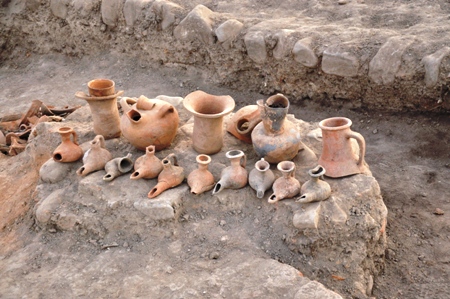New cultural monuments found in Azerbaijan

By Nazrin Gadimova
New cultural monuments have been found during an archaeological expedition in Azerbaijan's Gabala city, which was the capital of Caucasian Albania many centuries ago. The expedition was held with the support of SEBA (Seoul-Baku) Azerbaijan-Korean Cultural Exchange Association.
According to Associate Member of the Azerbaijan National Academy of Sciences (ANAS), Head of the Institute of Archeology and Ethnography's Gabala archaeological expedition, Ilyas Babayev, during the researches in the Gala area of Gabala, whose age refers to Late Antiquity and the early Middle Ages, a cultural layer relating to the 9-10th centuries was found.
Babayev said that during the researches water supply and sewerage systems, fragments of buildings, various ovens, clay and glass vessels and jewelry made from copper were found. Tombs, which were found in the Gala settlement, indicated that people were buried in the courtyard. Hand grenades filled with gunpowder are among the interesting findings.
According to ANAS, the archeological researches continue.
Moreover, an archaeological expedition of the ANAS Institute of Archeology and Ethnography during its work in the Sheki, Gakh and Oguz regions, has discovered new monuments dating back to the ancient period of Caucasian Albania. This archaeological expedition conducted excavations on the territory of the Yonjali settlement and the necropolis located in the Fazil village of Azerbaijan's Sheki region. During the excavations several graves were discovered at the necropolis.
As a result of the excavations an opportunity to trace the history of the ancient Albania in the Caucasus emerged. It was established that the entire upper part of the necropolis is a cemetery. The history of this cemetery is similar to the period of the Khojaly-Gadabay culture.
Earlier, it was reported that during archaeological research in Galatepe village of Azerbaijan's Agdjabedi region, a 9-meter deep cultural layer, including a wall made of bricks dating back to II century BCE to II century AD, a public building occupying space of 56 square meters, a hall and a street were discovered. These finds show the high development of brick architecture in Azerbaijan in the ancient period. The base of the 9-meter deep column made of limestone, hearths, a layer of ash, remains of burnt wood, red ceramics with rich patterns, flooring plastered with clay, and 40 centimeters wide reinforced soil were found.
